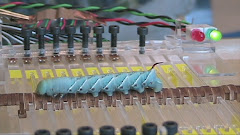
Saturday, April 11, 2009
Body pressure controled by the smart integuement...
Integument of soft-bodied animals is often a very interesting biomaterial. Besides unfolding and stretching to accommodate growth, it may function as a body pressure monitor in some instances. More specifically, the viscoelastic effect of the Manduca body wall prevent stress from building up as the body volume increases. When the caterpillar lost body volume, the body wall will automatically shrink to maintain the body pressure. The above effect might sound like a typical barometric reflex in mammals, except that this is done via the passive properties of the cuticular integument. Indeed, a simple reflex may be substituted by a smart material! The following graph shows the "adaptation" response found in the body wall, muscles, and the stretch receptor organ lining along the body axis. More detailed experimentation on caterpillar body pressure is ongoing.


Subscribe to:
Post Comments (Atom)

.jpg)
It's interesting.
ReplyDelete智能體被控制的體壓……
軟體動物的覆蓋物〈體被〉往往是一種非常有趣的生物材料。除了開展和延伸以適應成長的增長之外,在某些情況下,其功能像是作為體壓監控器;更具體地說,當身體容量增加,〈煙草蛾幼蟲〉體壁的粘彈效應防止身體壓力昇高,而當毛蟲失去體容量,體壁會自動收縮,保持體壓。上述作用也許聽起來像哺乳動物典型的氣壓反射,這樣做不同的只是通過表皮體被,一種被動屬性之角質體壁。事實上,一個簡單的反射,可用智能材料來取代! 下圖表顯示:沿著體軸方各,在體壁、肌肉和器官的拉伸受體襯裡發現了〈適應反應〉。
更詳細毛蟲身體上的壓力實驗仍在持續著……。